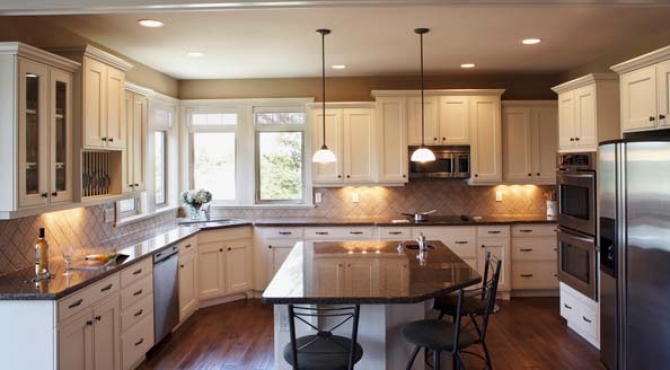Most of us have lived in homes and apartments (even boats) with small-space kitchens. My old brownstone apartment on New York’s East Side had a kitchen the size of a tiny closet but I managed to prepare meals and entertain within its space limitations. Despite their limited size, small kitchens can be organized and efficient, accommodating the needs of a cook working between sink, cook top and refrigerator.
The three areas of the work triangle are defined by the National Kitchen and Bath Association (NKBA) as “an imaginary straight line drawn from the center of the sink, to the center of the cook top, to the center of the refrigerator and, finally, back to the sink. While it’s geometrically impossible to achieve a true triangle in a one-wall kitchen, efficiency can still be achieved through the configuration of three items—sink, cook top, refrigerator, and how far apart they are.
The work triangle principle is used by kitchen designers and custom home designers when designing residential kitchens. While the majority of shapes in a kitchen are four-sided, from rectangular cabinetry to refrigerator and other square appliances, the triangle has always been, and remains, an important element of a kitchen's design and functionality. The concept was developed in the 1940’s when traditional kitchens were smaller and more utilitarian and there was just one cook who prepared and served meals for a family who sat down together for dinner each night in a separate dining area. At a time when household income was tight and there was only one wage earner in the family, the work triangle also helped save construction costs by standardizing kitchen design.
As defined by the NKBA, the design parameters of a kitchen triangle are:
- No leg of the triangle should be less than 4 feet (1.2 m) or more than 9 feet (2.7 m).
- The sum of all three sides of the triangle should be between 13 feet (4.0 m) and 26 feet (7.9 m).
- Cabinets or other obstacles should not intersect any leg of the triangle by more than 12 inches (30 cm).
- If possible, there should be no major traffic flow through the triangle.
- A full-height obstacle, such as a tall cabinet, should not come between any two points of the triangle.
Efficiency is the triangle's main goal, as it keeps all the major work stations near the cook, without placing them so close that the kitchen becomes cramped. The work triangle is also designed to minimize traffic within the kitchen so the cook isn't interrupted during food preparation.
As the baby boomer generation’s wealth increased, lifestyles changed and kitchens grew in size and function, becoming more of a social center and place to entertain friends and family. With these changes, designers have had to adapt the standard work triangle to include computer stations, flat screen TV’s, service bars, large work islands, multiple sinks, prep stations, and even baking areas, with two or more people sharing cooking duties in the household. Today when custom kitchen plans are drafted they may include multiple work triangles or even cooking zones similar to commercial kitchens. This allows for commercial style appliances, and zones for various functions outside of the traditional triangle.
If you’re designing a new kitchen, or remodeling an existing one, your lifestyle should determine its function and role in the overall plan. The work triangle is still a helpful tool and guideline, which can reduce unnecessary movement in the kitchen, making best use of available space. The triangle can be customized by your designer or architect to accommodate your individualized needs and preferences. Amazingly, more than 70 years after its introduction as an ergonomic design principle, the work triangle endures as a key element of a custom kitchen’s design and efficiency.








